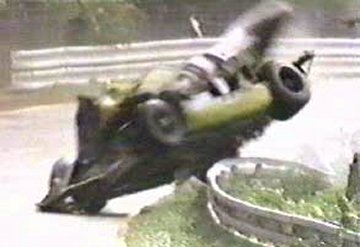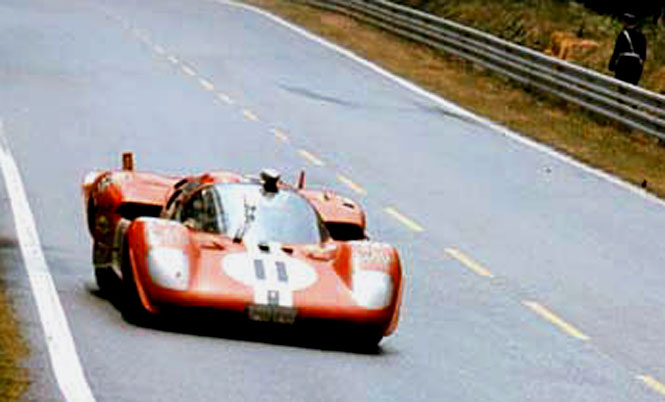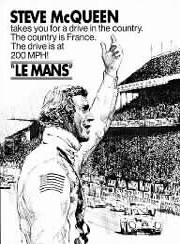
|
|






At The Movie - Part 1 |
By Mike Twite (CAR December 1970) Will The Real Le Mans Stand Up? It was my first time on a film set, although the 'set' was very familiar ground to me as it was the pit area at Le Mans. As all the world knows, Steve McQueen is shooting his epic which is titled simply The 24 Hours of Le Mans and I was anxious to see if film sets and the people who work on them were as I had imagined. Did a wizened old man hobble out in front of the cameras with a clapper boards? Did the director shout 'Roll' and 'Cut' and 'Print it'? Were there canvas seats with the stars' names stencilled on them? did the female lead prance and posture even when she wasn't on set? Yes! It's all absolutely true, I'm delighted to say. My illusions for once were not shattered. Director Lee Katzin smokes constantly, even while eating his lunch, and smokes cigarettes, pipes, cigars wihtout noticing what's in his mouth. On one traumatic occasion he rushed from the set to his little canvas seat with his name stencilled on it and out of a side pocket produced a bottle filled with a blue liquid; he gulped it down and tore back to the pits to grapple with the problem in hand. In contrast, Steve McQueen is quiet, self effacing, melts into the background, rides away on one af his fleet of motorcycles with his wife on the pillion and keeps himself to himself. McQueen's motorised activities on celluloid have been eulogised too many times to bear repeating here, but suffice it to say that his exploits in Bullits did as much for his image as his entire screen career before that. He has nutured an ambition to make a realistic film about motor racing for many years but it was not considered 'box office' by the film moguls even though mundane screen epics like Grand Prix and Winning did well enough at the box office to change that view. He was all set to make a motor racing film called The Champion three years ago but illness put paid to that, then Grand Prix came along and the project was shelved. The ambition did not die and although he kept his hand in on such films as The Thomas Crown Affair (remember the beach buggy antics?) and Bullit, followed by The River, which is now on release, the idea of a motor racing film never moved far from his mind. The opportunity to do a film of Le Mans came up and now that he had his own production company he was less in the hand of film moguls, although the backers did kick up when he announced that he would drive with Jackie Stewart in this year's race. They had their way eventually and for three weeks McQueen was unapproachable, but he came round and properly now realise that it would have been expensive and awkward if he had been injured during the race. |
McQueen felt that a good film could be made by filming a major motor race 'straight', without any serious attempt at providing a script. This horrified everyone connectedwith the film, who couldn't see the general public sitting through a 1½ hour film about pure motor racing with no 'love interest' or story of any kind. So McQueen was persuaded to accept a screenplay, but in the early days of shooting he fell out with first director John Sturgess over several things, but mainly the script. Sturgess finally quit the picture and a new director, Lee Katzin, was appointed. Katzin is mainly noted for his direction of TV series like Mission Impossible and It Takes a Thief, but he done film directions - his major success being Whatever Happened to Aunt Alive? He was on his way to San Francisco to do a TV movie when the call to Le mans came, but he quickly adapted to the new film, and is respected by the crew. As a cynical and suspicious motoring journalist I approached the film set ready to pick holes in everything, but I came away impressed beyond measure. Everyone connected with the film is concerned in making it accurate in every possible way, even if the difference between doing it right and nearly right is thousands of dollars. Unlike Grand Prix in which F3 cars with ghastly looking simulated F1 bodies trundled round to the annoyance of enthusiasts, Le Mans uses 25 of the cars which took part in this year's race plus most of their drivers. The only serious faking that was done was to dress up a couple of Lolas to look like Ferrari 512S and a Porsche 917 for the crash scenes, because even Solar Productions blanched at the thought of shunting a pair of £14.000 cars. But I defy you to say when you see the film (hopefully June 1971 is the release date, just prior to next year's Le mans race) that you can tell the difference between a real Ferrari and the 'Lolari'. I had to have a good look round the 'Lolari' before I spotted the difference, and so lifelike is the dummy driver who occupies the driving seat during the shunt that I absentmindedly wandered up to have a chat to him! |
There are two major crash sequences in the film. I was fortunate enough to be present when the 'Lolari' was crashed and afterwards I saw the rushes (that film jargon again!) of both that crash and the Porsche one. I can categorically state that they provide the finest racing car crash sequences I have ever seen. When the rushes were shown to the crew everyone burst into applause at the superb camerawork. Extensive use is amde of slow motion film, which shows the 'Lolari' disintegrating in minute detail from every possible direction since 11 cameras were used to film the sequence. as no stunt were used be expected to hurtle into trees at 100 mph, control operationtogether with a cine camera inside the car to record the crash from the driver's viewpoint. British club driver Malcolm Sear assisted in setting up the cars for these shunts and can tell of many hairy moments as the guinea pig in the driving seat whilebeing guided by radio control. The first two attempts to crash the 'Lolari' went wrong because the car veered off course and shunted the guard rails, but on the third attempt it hurtled down at full throttle in first gear (the car had a bog standard Chevy engine with hydraulic valve lifters so it couldn't come to much harm through over-revving) hit the sandbank at nearl 1000 mph and soared into the air, knocking down a Martini sign, brushing through the three tops, and crashing back to earth with an almighty thump which broke all the suspension. Since there was a camera crew only 50 yards ahead, Malcolm Sear cut the engine as soon as the car hit the bank, a fortuitous move because there would have been several dead or injured cameramen if he hadn't. The car had originally been intended to pass through the threes and knock them down, but it went so high that it passedover most of them. The crew ahd carefully sawn through the trunks of the trees so that they would snap off more spectacularly, but a high wind blew up a day or two before the crash was to be staged and blew severalof them down! Miraculously, for the purposes of the film, the driver survives the crash and runs away just as the car blows up. Of course this sequnce was shot szweveral days later and dynamite was used ti disintegrate the Lola. Amazingly, soemone actually bought the tatty remains - so beware if you are int he market for a Lola T70 - if the vendor says it has blown up he really means it! |
Porsche 917 chasing a Ferrari 512S |
One unintentional disaster was when the Ferrari 512S Derek Bell was driving caught fire and burnt out while returning from a filming sequnce. Derek recieved some nasty face burns and the ferrari was totalled, although someone bought that soggy heap, too! Professional to the last, one of the cameramen groaned 'Hell, and we didn't have a single camera there.' Poor David Piper also shunted his Porsche 917 when returning from a filming session, and he was unlucky enough to put himself out of action for some time with a badly broken leg. The other intentional crash is that of another Lola dressed up to look like the Gulf POrsche that Steve McQueen drives in the film. This time the car is made to brush the guard rail near Maison Blanche, then thunder across the road to crunch the opposite barrier. The rushes of this sequence are again quite superb because the car is shown to disintegrate in slow motion, while the telephoto shots are some of the most superb action shots I have ever seen. McQueen (alias Mike Delaney in the film) survives the crash, returns to the pits and takes over another Gulf Porsche. An amusing part of the crash which probably won't be seen in the final edited version is that the radio control equipment was damaged in the crash and there was no way of stopping the engine running at full throttle. The car wedged itself against a barrier and sat there with the rear wheels spinning until first the tyres then the mag wheels were ground away. Eventually a brave soul ventured into the smoke and switched it off. |
Ferrari or 'Lolari'? |
The film actually started way back in early 1969 when a film crew went to Le Mans to film the race and take mountains of notes about the circuit, the crowd, the cars, drivers, pit crew, girl friends, and all the million-and-one items which make up a motor race. Orders had to be placed for hundreds of items of clothing, like anoraks, umbrellas, caps plus mountains of other equipment. The drivers' Nomex equipment had to be spot-on, down to such minutiate as names and blood groups being stitched on th the overalls, the decals on the cars had to be authentic, even the drivers' wrist watches had to be correct. Before the 1970 race all the owners of advertising signs were asked if they would leave their boardings in position for the film - not that any of them were likely to refuse such free advertising! But it all had to be taken down and stored because souvenir hunters would have nicked it. All the owners of trade caravans were asked if they could bring their vehicles back for the paddock scenes to give the authentic touch. The attention to detail ran to such items as making the drivers' suits dirtier as the race wore on - a difficult job as sometimes early were shot after late ones. The cars had to get dirtier as the race progressed and even worse, mechanics, drivers, spectators, photographers all ahd to sprout stubbly chins for the early morning scenes. The shooting schedule reminded everyone not to shave in the mornings before shooting started, and if anyone forgot, they had to be made up to look black bearded. Where possible the crew used real people to do the jobs they did at the actual race, so many marshals, gendarmes, mechanics and so on played the same part as they played in the real race. They even imported some real motor racing photographers to play themselves because the extras who were given the job originally did not look authentic. Your humble servant was even given the job of playing a cine cameraman, although he was a complete novice! |
A Porsche-wannabee Lola in a movie crash |